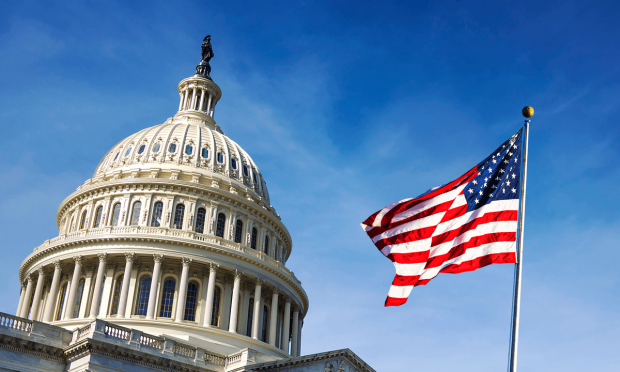House Bill Would Ban Algorithmic Stablecoins for 2 Years

The latest version of an on-again, off-again House bill regulating stablecoins would place a two-year ban on dollar-pegged digital assets like TerraUSD, which collapsed in a $48 billion bank run-style panic in May.
Despite being widely considered a priority in both houses of Congress, repeated attempts to overcome partisan differences over state versus federal regulation and whether nonbank institutions would be allowed to issue stablecoins have failed over the past few months.
Read more: US Stablecoin Bill Hits a Snag as Negotiations Break Down
The current bill being negotiated by the House Financial Services Committee’s chairwoman, Maxine Waters of California, and its ranking minority member, Patrick McHenry of North Carolina, would effectively ban any token not 100% backed by a reserve of dollars or highly liquid securities like short-term treasury bills.
The TerraUSD algorithmic stablecoin’s value was supported by an arbitrage mechanism with another cryptocurrency token, LUNA, that failed. This and similar stabilization mechanisms would be the subject of the moratorium, which would make it illegal to create or issue one, Bloomberg reported Tuesday (Sept. 20). Others, like No. 4 stablecoin Dai, with $6.9 billion in tokens circulating, are backed by reserves of other cryptocurrencies.
See also: $45B Stablecoin Rout Confirms Worst Fears about Crypto’s Need for Reserves
More specifically, the ban would be on “stablecoins marketed as being able to be converted, redeemed or repurchased for a fixed amount of monetary value, and that rely solely on the value of another digital asset from the same creator to maintain their fixed price,” the Bloomberg report stated.
Who Should Issue?
The draft bill would require a study on algorithmic and crypto-backed stablecoins by the Treasury Department, with input from the Federal Reserve, Office of the Comptroller of the Currency (OCC), Federal Deposit Insurance Corporation (FDIC), and Securities and Exchange Commission (SEC).
Proposals by the President Joe Biden administration to require all stablecoin issuers be FDIC-insured and OCC-regulated banks have been non-starters with Republicans and more than a few Democrats who want state-chartered banks and financial institutions (FIs) to be able to issue stablecoins as well.
Read more: A Primer on US Stablecoin Regulations
The bill under consideration by Waters and McHenry would allow both banks and nonbanks to issue stablecoins, with the OCC overseeing the former and the Fed ordered to establish an approval process for the latter.
State-approved nonbank stablecoins would be legal, but issuers would be required to register with the Fed within 180 days.
Will it Work?
Aside from the partisan differences, such a bill would have a potentially bigger hurdle to overcome: Virtually all such algorithmic stablecoins are decentralized finance (DeFi) projects that claim to have no governing body, human managers or jurisdiction where they are issued. Instead, they are — in theory — controlled by decentralized autonomous organizations (DAOs) that are controlled by self-executing smart contracts managed by token-holder votes.
While enforcement bodies from the U.S. Department of Justice and SEC to international organizations including the Financial Action Task Force (FATF) and Bank for International Settlements (BIS) have said this is truer in theory than in fact, as many are still at least partially controlled by developers who created them, the decentralization would still make a ban hard to enforce.
There is, the BIS said, “a vast gulf between the crypto vision and its reality” when it comes to DeFi’s actual decentralization.
For one thing, in several cases where DAO-run DeFi projects ran into legal difficulties, developers — or at least those in certain jurisdictions — simply burned their private key codes giving them back-end control.
For another, while private stablecoin issuers including Tether (USDT), Circle (USDC) and Binance (BUSD) can technically freeze their digital assets, the same isn’t true of DAO-controlled stablecoins. And that would make it difficult, if not impossible, to prevent their use in any cryptocurrency exchange not based in or doing business with U.S. customers.
See also: Another Hack, Another Collapse as Stablecoin Woes Follow Familiar Pattern
No CBDC Permission
One thing that has been negotiated out of the bill is a somewhat unrelated provision that would have formally authorized the Federal Reserve to begin the process of studying whether a digital dollar is actually wanted and needed, CoinDesk reported.
The Treasury Department recently came to the same conclusion as the Federal Reserve in recommending that the government work on developing the technology for a U.S. central bank digital currency (CBDC) — a process that will require at least five years to be launch-ready by several estimates — while working on whether to actually issue one.
Read more: Lawmakers Ask Fed to Speed up CBDC Project
The Fed has been very clear that it wants formal Congressional approval before beginning the process of deciding whether to launch a CBDC. But all the Waters-McHenry draft bill does is authorize another study, the article said, citing sources with knowledge of its contents.
For all PYMNTS crypto coverage, subscribe to the daily Crypto Newsletter.